Watch our Roundabouts video series.
Learn more about roundabouts.
Thousands of people are impacted by traffic collisions each year in Durham Region.
The Region of Durham is responsible for improving safety for all road users, which include pedestrians, cyclists, motorists, and vehicle passengers. The public also has a responsibility to be safe by following the rules of the road and never driving under the influence of drugs/alcohol or while using your cell phone.
Texting drivers are 23 times more likely to be involved in a crash or near crash than a non-distracted driver. According to the National Highway Traffic Safety Administration, distracted driving is a factor in 14 per cent of all police-reported motor vehicle traffic crashes.
Learn all about pedestrian safety
The major causes of deadly crashes are:
| Distracted driving |
|
A distracted driving charge can cost you a fine over $600 and demerit points.
If you are a new driver in the graduated licensing system, you will not get any demerit points; you can lose your license or have it cancelled. See the Ministry of Transportation for details on licence suspensions for new drivers.
Anything that distracts you from driving falls into this category, such as:
- Anything that takes your eyes off the road.
- Anything that takes your hands off the wheel.
- Anything that takes your mind off driving.
- Talking on a cell phone.
- Sending or reading texts.
- Reading anything (including maps).
- Changing the controls in your car (even mirrors, music and air or heat)
- Eating or drinking.
- Controlling your hands-free GPS (navigation system).
Tips for driving text-free:
- Confirm your plans ahead of time.
- Check for directions before you leave.
- Turn off your phone while driving.
- Set up an auto-reply for your messages.
- Move your phone out of sight and reach.
- Pull over and stop to safely call or text someone.
- Ask a passenger to check incoming messages for you.
- Don't text or call friends if you know they are driving.
- Tell your driver you can answer their phone if you are the passenger.
- Tell your driver you do not feel safe if they use their phone while driving.
Distracted driving videos:
|
| Drug and alcohol impaired driving |
Impaired driving means driving a vehicle while you are affected by alcohol or drugs. Vehicles include cars, trucks, boats, snowmobiles and off-road vehicles.
The penalties for drug impaired and alcohol impaired driving are the same.
Even small amounts of a drug can affect your ability to drive safely. It's illegal to drive impaired whether it's from over-the-counter medication, prescription drugs, alcohol or drugs (including marijuana).
Marijuana affects your ability to drive safely. This is because the tetrahydrocannabinol (THC) found in marijuana can affect your co-ordination, reaction time, attention, decision-making, and ability to judge distances. The effects of marijuana can last for more than 24 hours.
Driving after using marijuana is not safer than driving after drinking alcohol. Using marijuana and other drugs together (such as alcohol or opioids), increases the effects of the drugs and can increase the risk of injury or death from a car crash.
|
| Speeding |
|
Approximately one person a day is killed in a car crash involving speed and loss of control. Speeding is driving over the speed limit, driving too fast for road conditions, or racing. The faster you drive, the more stopping distance you will need to stop (and speed makes it harder to stop). At all times, keep a safe distance between you and the vehicle ahead of you.
The fines and penalties for speeding depend on how many kilometres you are over the speed limit.
|
| Not wearing seat belts |
Not wearing your seat belt is against the law. Having passengers (including the driver) in your car who are not wearing a seat belt can be very dangerous and can lead to injury or death in a collision or driving incident.
Watch the powerful Embrace Life - always wear your seat belt video
|
Strategic Road Safety Action Plan
The Works Department has developed a strategic road safety action plan program for the Region of Durham. The study sets out targets, policies and action plans to guide the Region and its road safety partners towards creating safer road and reducing the number of collisions. Working with our partners in engineering, enforcement, education and emergency medical services will ensure the success of the program.
Durham's approach sets a long-term goal to achieve zero fatalities and injuries with the objective that any loss of life is unacceptable.
| Durham's Safety Improvement Program |
|
The Region of Durham's Safety Improvement Program identifies locations with a potential for significant safety improvement based on collision severity and the performance of the location when compared to other similar locations.
Road safety audits, traffic operation studies, fatal investigations and corridor reviews are conducted at identified locations to determine the most appropriate safety measures. These measures may include items such as line marking changes, improvements to signs, landscaping and lighting. In some instances a traffic signal or other traffic control device is justified based on industry standards and incorporated into the Region's capital budget.
|
| Speed control |
|
Posted speed limit signs advise motorists of the maximum speed considered safe for travelling on roadways under normal operating conditions. The speed limit is established in order to give motorists sufficient time to react to a potential hazard that they may encounter.
Each year, municipalities receive numerous requests to have stop signs or traffic control signals installed to reduce speed. However, the purpose of stop signs and traffic control signals are to assign the right-of-way at intersections, not necessarily to control speed.
Speed limits are determined based on traffic engineering surveys. These surveys analyze roadway conditions, collision history and vehicle operating speeds. A safe and reasonable speed limit is usually set according to these conditions. Installing an artificially lowered posted speed limit may inadvertently result in drivers disregarding the speed limit, creating a more hazardous condition.
Traffic flowing at a uniform speed increases safety and results in fewer collisions. Drivers are less impatient, pass less often, and are less likely to tailgate. Appropriate posted speed limits simplify the work of police officers since most of the traffic is moving at the posted speed. Blatant speeders are easily spotted, safe drivers are not penalized, and police officers are not asked to enforce and defend unrealistic and arbitrarily posted speed limits.
|
| Pedestrian safety |
|
Pedestrian safety concerns all road users. When a collision involves a vehicle and a pedestrian, it is the pedestrian who most likely suffers, often with tragic results. It can be difficult for a motorist to avoid an unexpected pedestrian in the roadway, especially at night or during inclement weather.
It is the responsibility of both driver and pedestrian to ensure the safety of each other by following some simple rules:
- Be smart by always crossing at an intersection where there is a traffic control device, such as a traffic control signal or a stop sign.
- Be sure that drivers see you by making eye contact with motorists before attempting to cross a road.
- Be alert by not wearing headphones or using your phone or other devices when crossing the road.
- Be careful by not attempting to cross until traffic has come to a complete stop.
If you are the driver, pay special attention to crosswalks and the sidewalks leading to the intersection when you approach, even if you have a green light.
All motorists including cyclists must stop and yield the whole roadway at pedestrian crossovers, school crossings and other crossing locations where a crossing guard is present. Only when all pedestrians and the crossing guards have crossed and are safely on the sidewalk may drivers and cyclists proceed.
- Must come to a complete stop to comply with the "stop for pedestrians" sign, proceed with caution and watch for pedestrians and cyclists.
- Must remain stopped until pedestrians have completely stepped onto the opposite sidewalk. Driver must yield the whole roadway to pedestrians.
- Must yield to vehicles after passing the crosswalk and only merge when safe to do so.
- If a pedestrian is waiting to cross, drivers must make a complete stop to let pedestrians cross safely.
- Look both ways, make eye contact with drivers to ensure vehicles clearly see you, and indicate that you want to cross.
- If a vehicle is too close to safely stop, allow the vehicle to proceed before entering the crosswalk.
- Only cross when it is safe to do so.
- Cyclists face the same responsibilities and fines as drivers. They must stop and yield at pedestrian crossovers when riding through crossovers.
- When crossing with pedestrians, follow rules for pedestrians: dismount and walk your bike across the road.
| Crossing at a traffic signal |
|
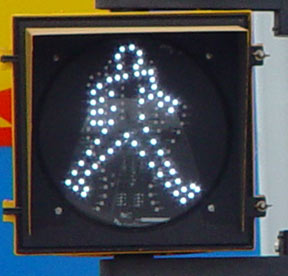 When crossing at a traffic control signal, cross once the walk signal is indicated. When crossing at a traffic control signal, cross once the walk signal is indicated.
To activate the walk signal you may have to press the pedestrian push button. If there is no push button, the walk signal will automatically indicate the walk signal. At some rural intersections, pedestrian signals may not be provided so use caution and cross during the green light making sure that all drivers see you.
If you have not completed your crossing and the flashing don't walk signal begins, continue your crossing as this is a warning to inform you that the light is going to change to the don't walk signal shortly. If you have not started to cross the road and the pedestrian signal head indicates the flashing don't walk signal, do not begin to cross as you do not have enough time to cross the intersection safely.
If you are crossing at a traffic light and there are no pedestrian signal heads, cross at the beginning of the green light. Do not cross once the signal changes to amber (yellow) and never cross against a red light.
Take extra caution when crossing in the dark Motorists have more difficulty seeing pedestrians in the dark, especially if they're wearing dark-coloured clothing. Wearing bright colours and reflective clothing is always a good idea in order to be seen when walking or cycling in the dark.
|
| Intersection pedestrian signal |
|
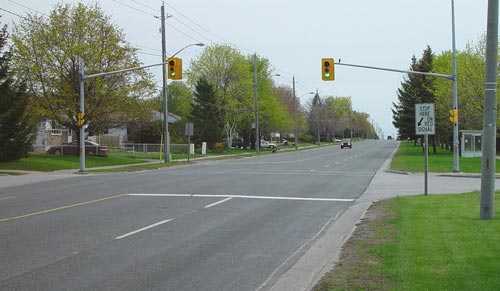 Where a greater level of control for pedestrian road crossing is required but a full traffic control signal is not, an Intersection Pedestrian Signal is an option. Where a greater level of control for pedestrian road crossing is required but a full traffic control signal is not, an Intersection Pedestrian Signal is an option.
An intersection pedestrian signal is a type of traffic control signal which instruct motorists to pay attention to the red signal indication and stop for pedestrians until the signal indication changes to green. On side streets, which are controlled by stop signs, motorists must treat an intersection pedestrian signal as they would any intersection by yielding right-of-way to the main street vehicle and pedestrian traffic.
Similar to intersection traffic control signals, certain criteria must be met before an intersection pedestrian signal is installed.
|
| Crosswalks and pedestrian signals |
|
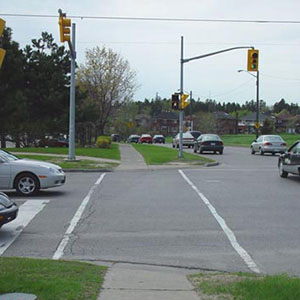 At signalized intersections and intersection pedestrian signals, there are painted crosswalks for pedestrians to walk in. At signalized intersections and intersection pedestrian signals, there are painted crosswalks for pedestrians to walk in.
Pedestrian signals are provided at the far side of the crosswalk to inform pedestrians when it is permissible to cross, that is, when pedestrians have the right-of-way. Although pedestrians may have the right-of-way, caution should always be used when crossing a road.
Pedestrian push-buttons are provided for certain pedestrian crossings.
Once the pedestrian push-button is activated, the signal will provide the opportunity for the pedestrian to cross. A pedestrian or vehicle may have to wait depending upon the time of day and how the signal is operating. It is important to be patient and wait to cross only when the walk signal is indicated.
If there is no pedestrian push button, the walk signal will indicate automatically every cycle; this usually occurs at busy intersections or at intersections with high pedestrian activity.
|
|
Pedestrian crossovers
|
|
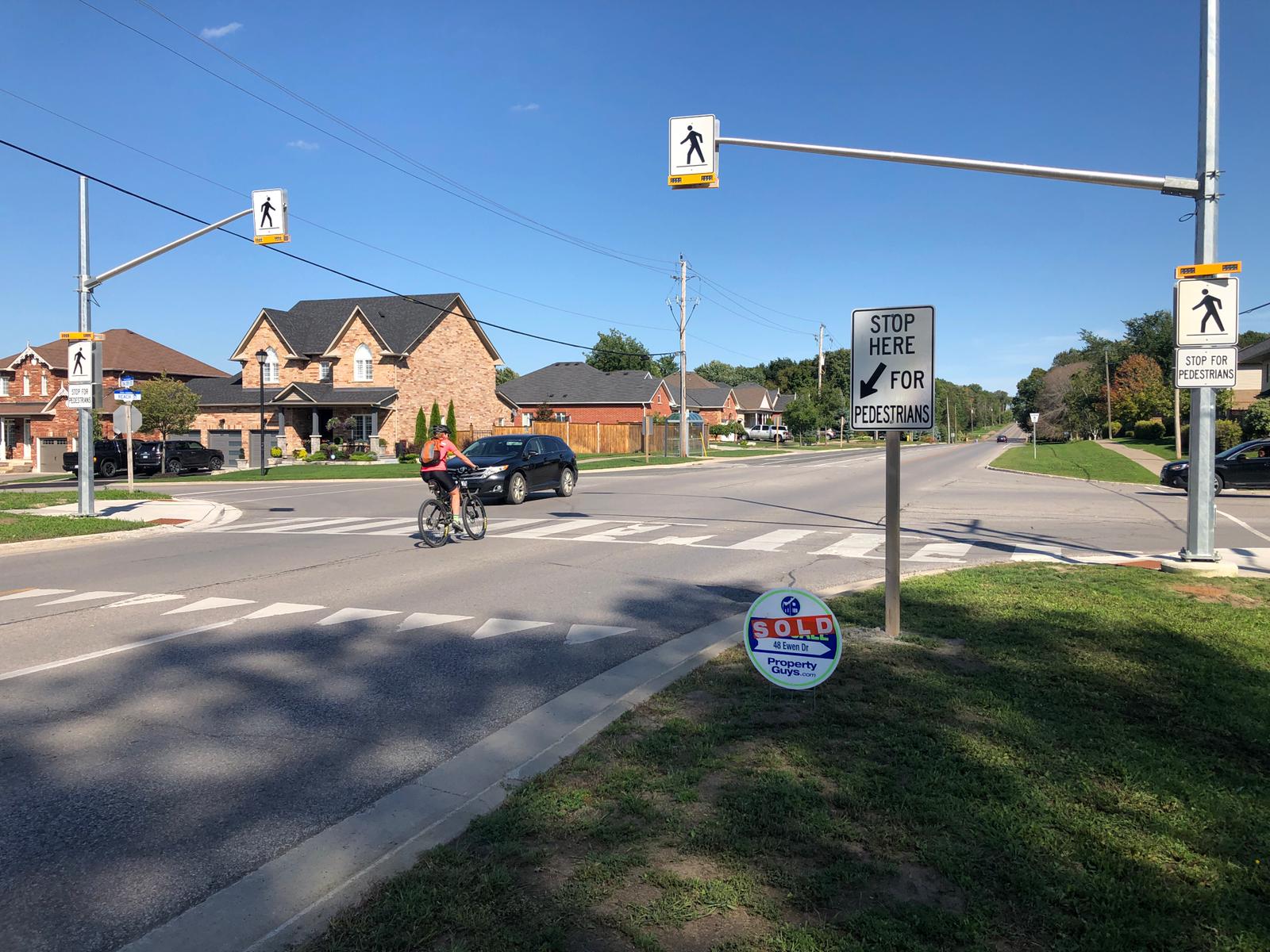 Pedestrian crossovers are a new way for pedestrians to easily and safely cross the road. By law, drivers and cyclists must stop and yield to pedestrians intending to cross the road, and wait for them to completely reach the other side before driving ahead. Pedestrian crossovers are a new way for pedestrians to easily and safely cross the road. By law, drivers and cyclists must stop and yield to pedestrians intending to cross the road, and wait for them to completely reach the other side before driving ahead.
Pedestrian crossovers have special ladder-style stripes that mark the crosswalk and marked yield bars showing where drivers must stop. Some crossovers have flashing lights that are activated by pedestrian push buttons. Signs are also present telling drivers to stop for pedestrians.
If there is a push button, press the pedestrian push button and cross when all vehicles (including cyclists) have come to a complete stop. If a push button is not present, be sure to make eye contact with motorists before stepping into the crossover. Motorists must come to a complete stop when signals are flashing or when pedestrians are within the crossover. Drivers must not proceed until the signals have stopped flashing or until pedestrians are no longer in the crossover.
|
|
| Fines |
|
Cyclists - An $85 fine will be issued to cyclists if/when failing to dismount from their bicycle and walk across the road at a pedestrian crossover. When riding through a crossover, cyclists face the same fines as drivers as they are considered vehicles under the Highway Traffic Act.
Pedestrians - A $35 fine will be issued to pedestrians if/when moving into the path of a moving vehicle, whereas the vehicle is too close to the crossover that it is unable to safely stop.
Drivers - A fine of up to $1,000, and four demerit points, will be issued to drivers if/when failing to yield at a pedestrian crosswalk
*Fines are doubled in Community Safety Zones. These areas are clearly marked with signs
|
| Types of Pedestrian Crossovers within Durham |
|
Pedestrian crossovers are identified by specific signs, pavement markings and sometimes lights. Some have signage overhead and pedestrian push buttons. There are three types of pedestrian crossovers within Durham Region:
Level 2 Type B
-
Identified by overhead signage in addition to a rectangular rapid flashing beacon.
-
Uses specialized yield pavement markings.
-
Typically used at high-volume crossings.
Level 2 Type C
Level 2 Type D
School Crossing
- A school crossing is any pedestrian crossing where a school crossing guard is present and displaying a school crossing stop sign.
|
Traffic control devices
| Roundabouts |
|
Roundabouts are non-signalized circular intersections designed to maximize safety and minimize delay. Traffic circulates counter-clockwise around the central island. Entering vehicles must yield to all traffic already in the roundabout.
Watch our animated video series on roundabouts to learn more.
| Benefits of roundabouts |
|
Roundabouts have many benefits, including:
Safety
Roundabouts reduce the number of conflict points and eliminate the most severe crashes from occurring. They operate at lower speeds and simplify the decision-making process as drivers only need to look in one direction for oncoming traffic.
Efficiency
Roundabouts generally reduce vehicle delay by allowing motorists to yield rather than stop at red signals. They are a good alternative at locations where there are heavy left-turn and fluctuating traffic patterns.
Reduced emissions and fuel consumption
Roundabouts reduce fuel consumption and vehicle emissions because vehicles are not idling at red signals.
The centre island of a roundabout provides an opportunity to beautify the location with lo- lying landscaping such as flowers.
|
| Roundabouts in Durham |
|
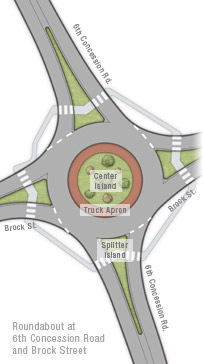 Unlike intersections controlled by traffic signals, motorists approaching a roundabout must yield the right-of-way to oncoming traffic and merge into the circle when it is safe to do so. Collisions that result in serious injury or fatalities from right angle impacts are significantly reduced with a roundabout. Unlike intersections controlled by traffic signals, motorists approaching a roundabout must yield the right-of-way to oncoming traffic and merge into the circle when it is safe to do so. Collisions that result in serious injury or fatalities from right angle impacts are significantly reduced with a roundabout.
An analysis is undertaken to ensure that a potential roundabout site meets specific criteria prior to construction.
|
| Driving in a roundabout |
|
When you enter the roundabout you must yield to circulating traffic. Yield means the other drivers in the circle have the right-of-way. An approaching motorist has to wait for a safe gap in the flow of traffic before entering.
- Slow down when approaching the roundabout.
- Keep to the right of the splitter island.
- Be aware of your surroundings. Watch for pedestrians and cyclists.
- Enter the roundabout only when there is an adequate gap in the circulating traffic flow.
- Vehicles in a roundabout have the right of way and move in a counter clockwise direction.
- Do not pass other vehicles or cyclists in the roundabout.
- Always signal before exiting. Maintain low speeds.
- Beware of pedestrians and cyclists crossing the road as you exit the roundabout.
Large vehicles
- Give other vehicles plenty of space.
- Use the truck apron around the center island when turning large trucks.
Pedestrians
- Cross only at designated crosswalks.
- Vehicles always have the right-of-way in the roundabout. Choose a safe time to cross.
- Never cross to the central island of a roundabout
- Step on the splitter island when crossing so you can safely cross one lane at a time.
Bicycles
- Experienced cyclists can travel through the roundabout using the same general rules as any other vehicle.
- Merge into traffic before entering the roundabout.
- Once inside the roundabout, ride in the middle of the lane so cars don't pass you.
- If you prefer to walk your bicycle on the sidewalk, dismount at the ramp. Continue on the sidewalks, following the same rules as pedestrians.
Emergency vehicles
- If you have not entered the roundabout, pull over to let the emergency vehicle pass.
- If you are already inside the roundabout, do not stop. Continue to your exit, then pull over to allow the emergency vehicle to pass.
|
| Always obey the signs and markings |
|
As you get closer to the roundabout entrance, it is very important to observe the signs and arrows.
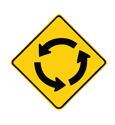 Roundabout ahead. Time to slow down. 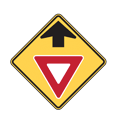 Yield sign ahead. 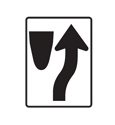 Stay to the right of the splitter when approaching the roundabout.
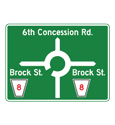 Guide signs near the entry show the correct exit to take. 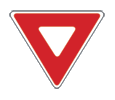 Yield to traffic on your left before entering the roundabout. 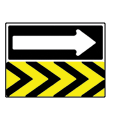 All traffic within the roundabout travels one-way. |
|
| Traffic signals |
|
Traffic signals are essential for the safe and efficient movement of traffic. They are used to designate right-of-way of conflicting movements.
The Traffic Engineering and Operations Division of the Works Department plans, designs, constructs, operates and maintains the traffic control signals in the Region of Durham, including the traffic signals on Regional roads, municipal roads and Provincial highways.
|
| Traffic signs and pavement markings |
|
Traffic signs and pavement markings are essential for the safe and efficient movement of traffic. There are a variety of signs installed across the Region to assist motorist with driving safely.
| Regulatory signs |
|
 Regulatory signs are signs that inform the road user of things they must do or not do. These signs indicate traffic regulations which apply all the time or at specific times. Examples are stop signs, speed limit signs, one way traffic signs, turn prohibitions and parking regulation signs. These signs typically have a white background with a black message except the stop and yield signs which have red and white colours and the unique octagon or triangle shapes. Regulatory signs are signs that inform the road user of things they must do or not do. These signs indicate traffic regulations which apply all the time or at specific times. Examples are stop signs, speed limit signs, one way traffic signs, turn prohibitions and parking regulation signs. These signs typically have a white background with a black message except the stop and yield signs which have red and white colours and the unique octagon or triangle shapes.
|
| Warning signs |
|
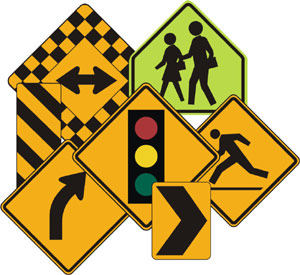 Warning signs provide advance warning of potentially hazardous conditions. Examples include curve and intersection warnings, stop signs or traffic signals ahead notice, and playground or school area warning signs. These signs typically have a yellow diamond or rectangular shape with a black message. Warning signs provide advance warning of potentially hazardous conditions. Examples include curve and intersection warnings, stop signs or traffic signals ahead notice, and playground or school area warning signs. These signs typically have a yellow diamond or rectangular shape with a black message.
|
| Directional guide signs |
|
 Directional guide signs provide information about street names, route numbers, highway exits and directions to nearby communities or services. These signs are generally rectangular in shape with a white message or a green background. Directional guide signs provide information about street names, route numbers, highway exits and directions to nearby communities or services. These signs are generally rectangular in shape with a white message or a green background.
|
| Temporary conditions signage |
Temporary condition signs and devices such as cones and barrels indicate construction, maintenance or utility work on the roadway. Many of the messages and symbols are the same as warning signs, but an orange background colour is used to highlight these unusual conditions. 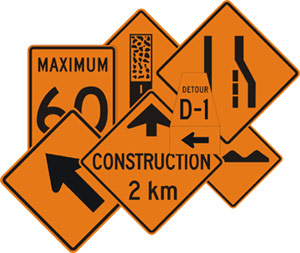 |
| Tourism directional signs |
|
Tourism directional signs inform the public of services, recreational facilities, tourist attractions, scenic points of
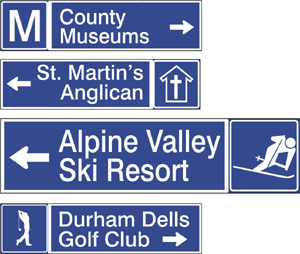 interest and other services or facilities that may be required or of interest to travellers. interest and other services or facilities that may be required or of interest to travellers.
|
|
Engine Brake Signs
|
|
Residents that live along regional road truck routes subjected to frequent engine noise may request courtesy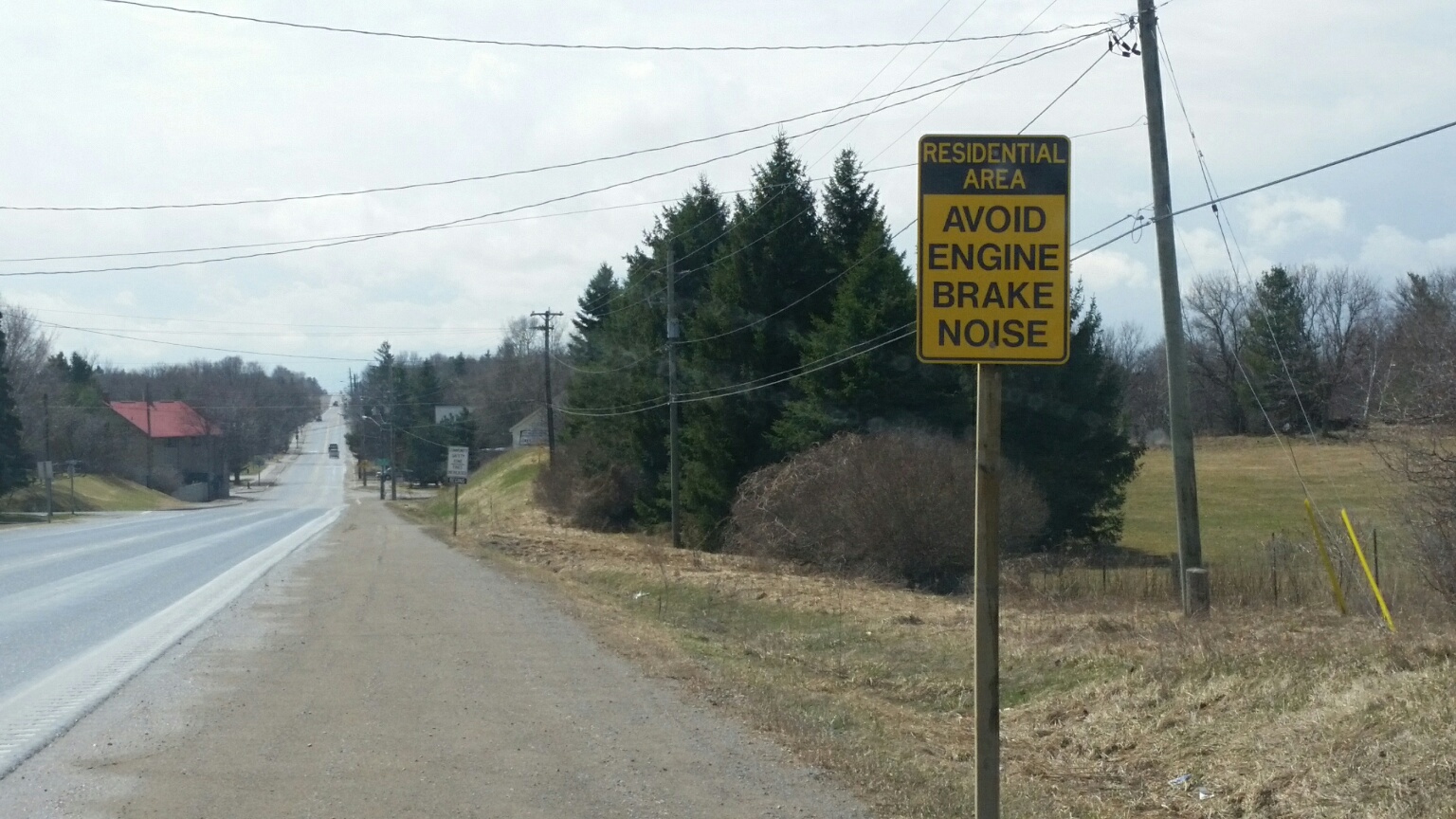 signs that are used to notify the truck drivers to refrain from producing unnecessary noise upon entry into an urban area. These signs will be provided where suitable conditions exist, and traffic observations support their use. Requests for this type of sign can be made using our "General Issues" form located on our Durham Regional website and including "Engine brake noise" in the issue message box or by a phone call to our reception desk. signs that are used to notify the truck drivers to refrain from producing unnecessary noise upon entry into an urban area. These signs will be provided where suitable conditions exist, and traffic observations support their use. Requests for this type of sign can be made using our "General Issues" form located on our Durham Regional website and including "Engine brake noise" in the issue message box or by a phone call to our reception desk.
|
|
|
Positive Offset Left Turn (POLT)
|
|
Durham Region, in support of Durham Vision Zero, is working with its road safety partners to create safer roads and reduce the number of collisions, road fatalities and injuries with the goal of having zero people killed or injured on Durham roads.
Designated intersections have been redesigned to incorporate Positive Offset Left Turns (POLTs). POLTs involve shifting the left-turn lanes to the left, away from the adjacent through lanes.
This design improves the sight line for drivers making left turns, by reducing the obstruction caused by opposing left-turning vehicles.
A majority of collisions occur at intersections. Specifically, intersections that are controlled by traffic control signals represent approximately 45 per cent of the collisions occurring in Durham. Collisions caused by turning movements are the most common types of collisions at intersections in the Region—representing approximately one-third of all fatal and injury collisions at intersections.
Benefits of POLTs
Enhanced visibility – Drivers have a better view of oncoming traffic making it easier to judge safe gaps for turning.
Reduced collision risk – By improving sightlines, the likelihood of collisions, especially those involving left-turning vehicles, is reduced.
Improved traffic flow – POLTs assist in smoother traffic movement at intersections, reducing delays and congestion.
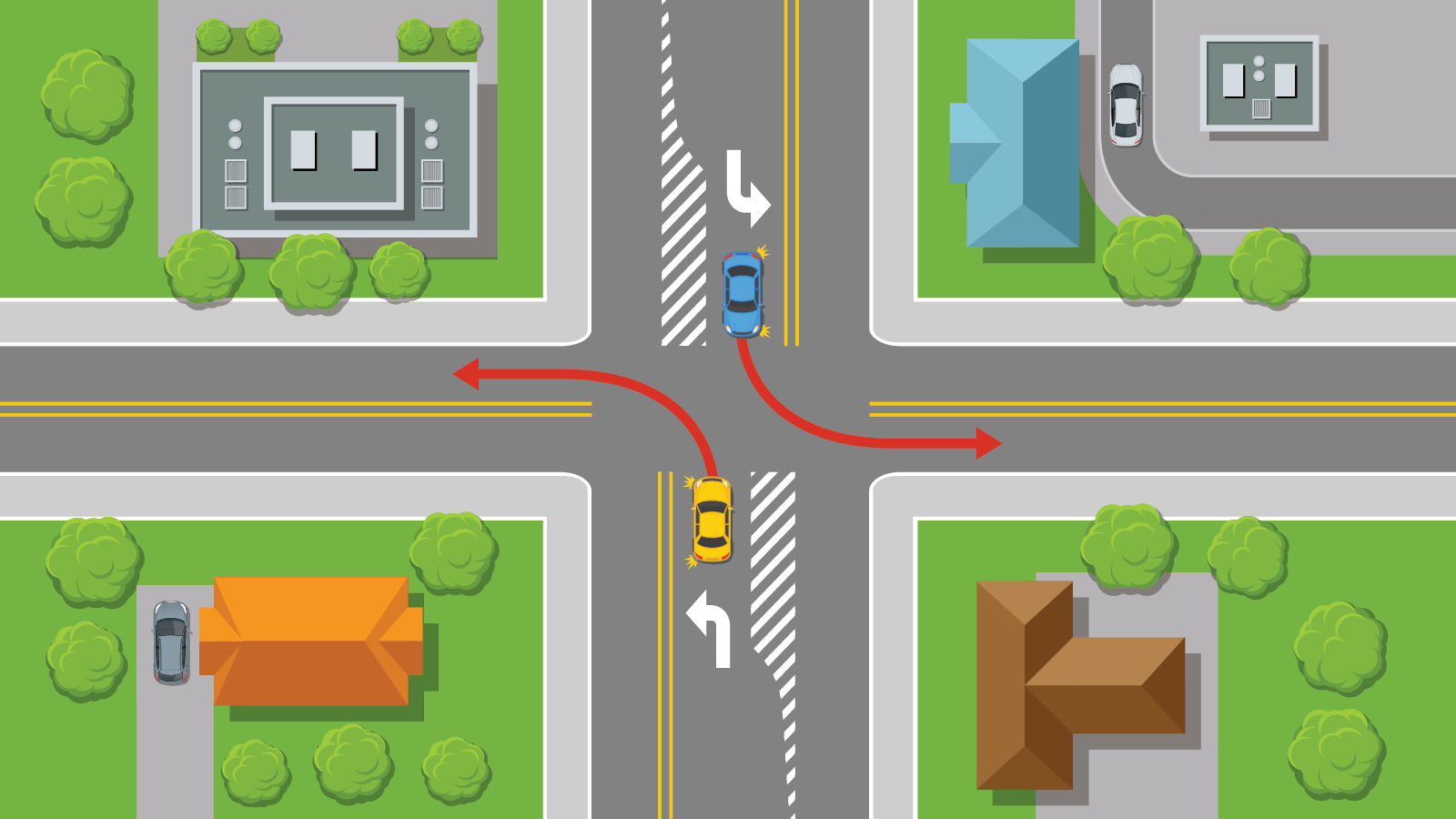
POLTS in Durham
An analysis is undertaken prior to detail design to review whether POLTs are appropriate at an intersection scheduled for Capital Road reconstruction. Specific criteria such as the ones listed below are reviewed to determine if POLTs are required or feasible:
- Inadequate sight distance – poor sight distance of oncoming traffic when an opposing left-turning vehicle is present.
- Crash history or observed conflicts between left-turning and opposing through vehicles.
- Opposing left-turn maneuvers overlap or cross paths.
- Other remedial measures are not feasible.
- Constructability.
Some existing intersections that have been reconstructed to include POLTs include:
- Simcoe Street (Regional Road 2) at all signalized intersections from Conlin Road to Winchester Road in Oshawa
- Bowmanville Avenue (Regional Road 57) and King Street (Regional Highway 2) in Bowmanville
- Whites Road (Regional Road 38) and Taunton Road (Regional Road 4) in Pickering
Other locations are planned in the Region of Durham’s Capital Road Program.
|
|
Reserved lanes
|
| Bus-only lanes |
|
Bus-only lanes are reserved for public transit vehicles only and designed to help buses get through congested areas and stay on schedule. A bus-only lane is not an HOV (high-occupancy vehicle, also known as carpool) lane, which allows vehicles carrying at least two people to enter and exit the lane.
The reserved bus-only lanes service Durham Region Transit (DRT) PULSE buses along Highway 2 (Kingston Road) that runs between downtown Oshawa and University of Toronto Scarborough campus. GO Transit buses also use these reserved lanes.
|
| Driving in and around bus-only lanes |
- Watch for pavement markings and signage, which have been provided at all intersecting roadways on Highway 2 to guide right-turning traffic into the correct lane.
- Dashed lane markings indicate where it is acceptable to change lanes to enter the bus-only lane to turn right.
- Change lanes only when it is safe to do so and when there is no traffic approaching in the reserved bus and bicycle lanes.
- When an emergency vehicle is approaching, motorists should enter the reserved lanes when safe to bring their vehicle to a stop as near as practical to the right-hand curb or edge of the roadway.
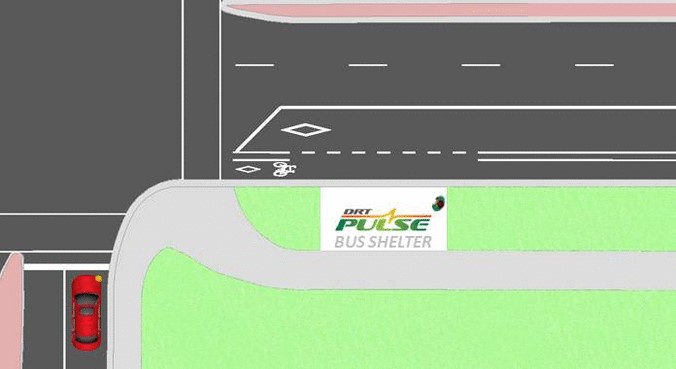
- Motorists turning right onto Highway 2 at an intersection are required to enter the mixed traffic lane (not the bus-only lane), when safe to do so.
- Motorists turning right from Highway 2 at an intersection with an exclusive right-turn lane are allowed to cross the bus-only and cycling lanes where the lane markings are dashed, permitting entry to the right-turn lane. Motorists must yield to buses and cyclists while merging into the right-turn lane:
- Motorists turning right from Highway 2 at an intersection without an exclusive right-turn lane are allowed to enter the bus lane where the lane markings are dashed and make the right turn from the bus-only lane. Motorists must yield to buses while merging into the bus only lane and to cyclists when turning right.
- Motorists entering from a driveway onto Highway 2 with bus-only lanes should yield to right-turning traffic, buses and cyclists. Motorists are required to exit the bus lane within 40 meters of entering and when safe to do so.
|
| Bicycle-only lanes |
|
A bicycle-only lane is reserved for cyclists only. Power assisted bicycles (including e-bikes and electric scooters) with a maximum speed of 32 km per hour are allowed in the bicycle-only lane. Personal mobility devices, including wheelchairs, electric wheelchairs and medical scooters are not allowed in the cycling lane.
Cyclists share the same rights and responsibilities as drivers and should bike safely.
- Be aware of buses entering the bicycle-only lanes at bus stops to pick up and drop off passengers.
- Only pass a stopped bus if you can do so safely.
- Yield to buses when they are leaving the bus stop.
- Watch for vehicles turning across cycling lanes at intersections and driveways.
- Yield to pedestrians and signal before turning or changing lanes.
- Power assisted bicycles (e-bikes and scooters) with a maximum speed of 32 km per hour are allowed in the cycling lane.
- Cyclists may enter mixed traffic from the cycling lane to turn left at an intersection.
- Cyclists may also dismount and use crosswalk to turn left at a signal.
- Where the cycling lane ends, cyclists must share the same lane as mixed traffic.
|
| Signs and markings |
|
Both the curbside bus-only lanes and bicycle-only lanes on Highway 2 are clearly marked with overhead diamond signs, ground-mounted diamond signs and pavement markings.
Signs and markings you might see around reserved lanes:
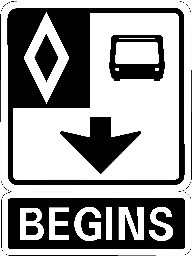 Overhead sign: bus-only lanes begin. Overhead sign: bus-only lanes begin.
 Overhead sign: bicycle-only lanes begin. Overhead sign: bicycle-only lanes begin.
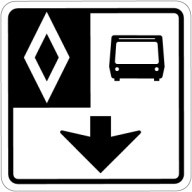 Overhead sign: lane reserved for buses only. Overhead sign: lane reserved for buses only.
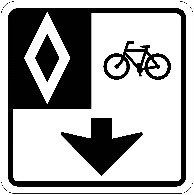 Overhead sign: lane reserved for bicycles only. Overhead sign: lane reserved for bicycles only.
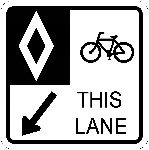 Ground-mounted sign: lane reserved for bicycles only. Ground-mounted sign: lane reserved for bicycles only.
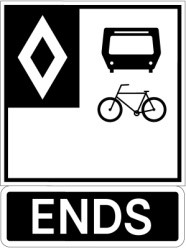 Overhead sign: bus-only and bicycle-only lanes are ending. Overhead sign: bus-only and bicycle-only lanes are ending.
 Pavement marking: bus-only reserved lanes. Pavement marking: bus-only reserved lanes.
 Pavement marking: Bicycle-only lanes. Pavement marking: Bicycle-only lanes.
|
| Fines and penalties |
| Driving in reserved lanes is not allowed, except to immediately access driveways or to turn at intersections. Drivers must exit the reserved lane not more than 40 meters from a point at which they entered the lane. Drivers may be charged for improper use of the bus-only lanes in accordance with the Highway Traffic Act. The fine is a minimum of $110 and three demerit points. |
|
School safety
Road safety resources for schools and educators
Kids Safety Village
The Kids Safety Village of Durham Region is a kid-sized version of a real town, located on the grounds of Sir William Stephenson Public School in Whitby. The village features small buildings, detailed roadways, traffic lights and road signs, an operational railway crossing, battery cars, bicycles and a classroom.
Children learn about road safety as a pedestrian and a cyclist in a controlled, supervised environment. This realistic setting has allowed thousands of children in Durham to test their safety skills in a fun, learning environment.
For more information, please visit the Durham Safety Village site for more information

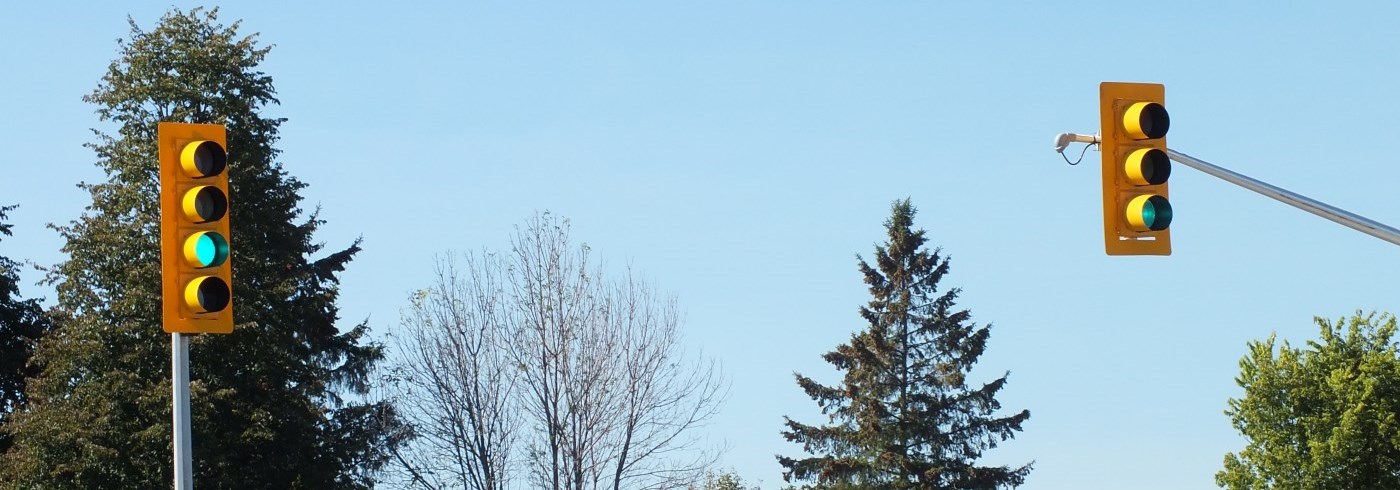




 When crossing at a traffic control signal, cross once the walk signal is indicated.
When crossing at a traffic control signal, cross once the walk signal is indicated. Where a greater level of control for pedestrian road crossing is required but a full traffic control signal is not, an Intersection Pedestrian Signal is an option.
Where a greater level of control for pedestrian road crossing is required but a full traffic control signal is not, an Intersection Pedestrian Signal is an option. At signalized intersections and intersection pedestrian signals, there are painted crosswalks for pedestrians to walk in.
At signalized intersections and intersection pedestrian signals, there are painted crosswalks for pedestrians to walk in. Pedestrian crossovers are a new way for pedestrians to easily and safely cross the road. By law, drivers and cyclists must stop and yield to pedestrians intending to cross the road, and wait for them to completely reach the other side before driving ahead.
Pedestrian crossovers are a new way for pedestrians to easily and safely cross the road. By law, drivers and cyclists must stop and yield to pedestrians intending to cross the road, and wait for them to completely reach the other side before driving ahead. Unlike intersections controlled by traffic signals, motorists approaching a roundabout must yield the right-of-way to oncoming traffic and merge into the circle when it is safe to do so. Collisions that result in serious injury or fatalities from right angle impacts are significantly reduced with a roundabout.
Unlike intersections controlled by traffic signals, motorists approaching a roundabout must yield the right-of-way to oncoming traffic and merge into the circle when it is safe to do so. Collisions that result in serious injury or fatalities from right angle impacts are significantly reduced with a roundabout. Roundabout ahead. Time to slow down.
Roundabout ahead. Time to slow down. Yield sign ahead.
Yield sign ahead. Stay to the right of the splitter when approaching the roundabout.
Stay to the right of the splitter when approaching the roundabout. Guide signs near the entry show the correct exit to take.
Guide signs near the entry show the correct exit to take. Yield to traffic on your left before entering the roundabout.
Yield to traffic on your left before entering the roundabout. All traffic within the roundabout travels one-way.
All traffic within the roundabout travels one-way. Regulatory signs are signs that inform the road user of things they must do or not do. These signs indicate traffic regulations which apply all the time or at specific times. Examples are stop signs, speed limit signs, one way traffic signs, turn prohibitions and parking regulation signs. These signs typically have a white background with a black message except the stop and yield signs which have red and white colours and the unique octagon or triangle shapes.
Regulatory signs are signs that inform the road user of things they must do or not do. These signs indicate traffic regulations which apply all the time or at specific times. Examples are stop signs, speed limit signs, one way traffic signs, turn prohibitions and parking regulation signs. These signs typically have a white background with a black message except the stop and yield signs which have red and white colours and the unique octagon or triangle shapes. Warning signs provide advance warning of potentially hazardous conditions. Examples include curve and intersection warnings, stop signs or traffic signals ahead notice, and playground or school area warning signs. These signs typically have a yellow diamond or rectangular shape with a black message.
Warning signs provide advance warning of potentially hazardous conditions. Examples include curve and intersection warnings, stop signs or traffic signals ahead notice, and playground or school area warning signs. These signs typically have a yellow diamond or rectangular shape with a black message.
 interest and other services or facilities that may be required or of interest to travellers.
interest and other services or facilities that may be required or of interest to travellers. signs that are used to notify the truck drivers to refrain from producing unnecessary noise upon entry into an urban area. These signs will be provided where suitable conditions exist, and traffic observations support their use. Requests for this type of sign can be made using our
signs that are used to notify the truck drivers to refrain from producing unnecessary noise upon entry into an urban area. These signs will be provided where suitable conditions exist, and traffic observations support their use. Requests for this type of sign can be made using our 

 Overhead sign: bus-only lanes begin.
Overhead sign: bus-only lanes begin. Overhead sign: bicycle-only lanes begin.
Overhead sign: bicycle-only lanes begin. Overhead sign: lane reserved for buses only.
Overhead sign: lane reserved for buses only. Overhead sign: lane reserved for bicycles only.
Overhead sign: lane reserved for bicycles only. Ground-mounted sign: lane reserved for bicycles only.
Ground-mounted sign: lane reserved for bicycles only. Overhead sign: bus-only and bicycle-only lanes are ending.
Overhead sign: bus-only and bicycle-only lanes are ending. Pavement marking: bus-only reserved lanes.
Pavement marking: bus-only reserved lanes. Pavement marking: Bicycle-only lanes.
Pavement marking: Bicycle-only lanes.